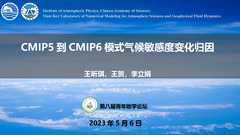报告详情
Comparison of Climate sensitivities between CMIP5 and CMIP6
编号:2747
访问权限:私有
更新:2023-04-12 15:09:22 浏览:654次
口头报告
摘要
The Equilibrium Climate Sensitivity (ECS) is an important metric in climate models in evaluating the global climate state, defined as the warming for a doubling of atmospheric CO2 concentration relative to preindustrial climate. Most studies select the 150 years simulation (whole stage) of the climate model, via the linear relationship between the global average surface air temperature (SAT) and the net radiation flux at the top of the atmosphere. The model climate behaves nonlinearly due to the mean-state biases and the inter-model spread in feedback evolution. We divide 150 years into fast stage (1-20 yrs) and slow stage (21-150 yrs) .The choice of year 20 is based on the maximum standard deviation of the 150-year global mean SAT in the abrupt4×CO2 experiment relative to the piControl run of multi-models that participated in Coupled Model Intercomparison Project phase 5 and phase 6 (CMIP5 and CMIP6). The standard deviation of CMIP6 is larger than CMIP5 models, due to its warming curve branch. Some models’SAT is higher (about 1K) in CMIP6 than in CMIP5, which is related to the changes of global mean precipitation and the temperature changes in the Arctic via inter-model spread. The study shows that prominent model spread in ECS results from uncertainty in different feedbacks: the cloud shortwave feedback is closely related to the simulation of the temperature and convective precipitation; the albedo feedback is closely related to the simulation of Polar region causing the higher multi-model mean ECS in CMIP6 than that in CMIP5.
关键词
ECS,climate model,feedback
报告人

王昕琪
中国科学院大气物理研究所稿件作者
全部评论
重要日期
-
会议日期
05月05日
2023
至05月08日
2023
-
03月31日 2023
初稿截稿日期
-
05月25日 2023
注册截止日期
主办单位
青年地学论坛理事会
中国科学院青年创新促进会地学分会
中国科学院青年创新促进会地学分会
承办单位
武汉大学
中国科学院精密测量科学与技术创新研究院
中国地质大学(武汉)
中国科学院精密测量科学与技术创新研究院
中国地质大学(武汉)



发表评论